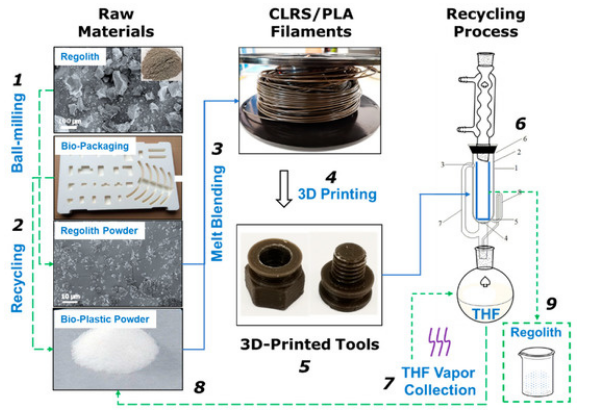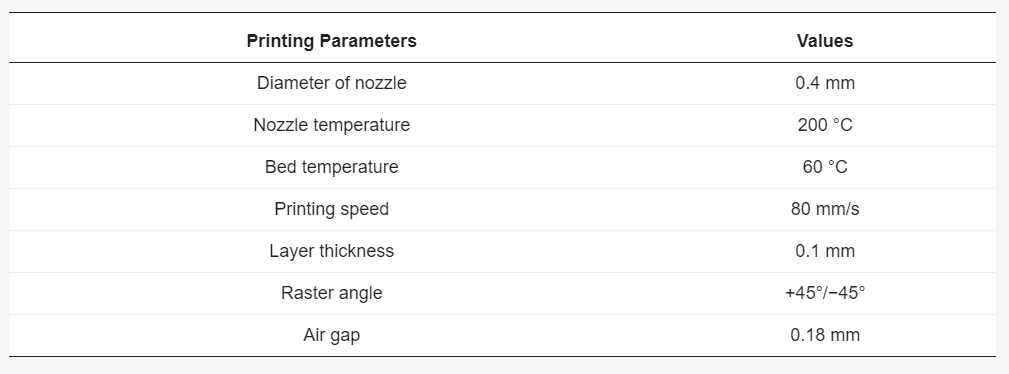The topic of moondust—or regolith—is continually fascinating, especially as it offers the potential for constructing habitats in space. Numerous studies have been performed by researchers investigating whether regolith is indeed the key to colonization, along with assessing what is involved in establishing communities on the Moon or other planets, and exploring other alternative materials.
Now, researchers from China are experimenting with a composite made up of PLA and lunar regolith simulant, an analogue of an Apollo 11 lunar soil sample attained from the Institute of Geochemistry at the Chinese Academy of Sciences.
With the goal of finding out whether PLA/CLRS-1 could be recycled and then reused, the researchers milled the regolith into fine powder and then dried both simulants before putting them into a high-speed mixer. Samples were designed using CATIA V5, 3D printed on a Funmat HT.
In this case, testing for tensile strength was critical. The researchers put all samples though liner elastic deformation from 4 % to 8%, but noted that thereafter, variances occurred:
“The 3D printed specimens made of PLA and PLA/CLRS-1 composites with 5 wt.% CLRS-1 yielded after the maximum stress (64.3 and 55.2 MPa) before fracturing. Meanwhile, the PLA/CLRS-1 composite specimens containing 10 wt.% CLRS-1 exhibited little plastic deformation prior to fracturing, although brittle fracture patterns were observed.”

Typical tensile stress–strain curves of 3D printed neat polylactide (PLA) and polylactide/lunar regolith simulant (PLA/CLRS-1) samples for different contents.
The team concluded that CLRS-1 exerted great influence on the properties and fracture modes of the samples.
In three-point bending tests, the samples did display linear elastic deformation; however, the composites broke after yielding. The neat PLA did not, with the authors pointing out that bending test results were close to the tensile results in terms of presenting increased modulus, decreased strength, and elongation.

Typical bending stress–strain curves of 3D printed neat PLA and PLA/CLRS-1 samples for different contents.
In situ resource utilization (ISRU) is critical to construction on the Moon or another planet as astronauts would not, in most cases, be expected to carry heavy materials like dirt with them. Recycling and reuse of regolith or composites allows for new items to be created quickly, with plastics like PLA turned into feedstock. This includes the fabrication of tools and supplies, with recycling achieved either during solvent dissolution or a grinding mechanism.
For this study, the researchers used a fat extractor reflux method, employing solvent for recycling in a process lasting around three hours:
“After the 3D printing process, the 3D printed PLA/CLRS-1 components were placed in an extraction thimble. Through the reflux of THF, the components slowly dissolved in the solution. The dissolved PLA was then refluxed into a flask along with the THF. The lunar regolith was sieved as needed, which then accumulated in the extraction thimble for collection after the dissolution of the 3D printed PLA–regolith components. Then, the PLA and THF were separated and recycled using the rotary evaporation method, then reserved for future use.”

Schematic diagram of the fabrication and recycling of the component, lunar regolith ball milling (1), PLA recycling (2), raw material regolith and PLA melt blending, extrusion (3), 3D printing (4), final 3D printed tools (5), recycling process (6), tetrahydrofuran (THF) vapor collection (7), recycled PLA (8), recycled regolith (9).
Analysis showed that recycled PLA could be reused, upon examining the chemical structure and molecular weight, which was only slightly reduced. The authors hope that in the future scientists will be able to rely on this new perspective for using and recycling materials with lunar regolith.
[Source / Images: “3D Printing and Solvent Dissolution Recycling of Polylactide-Lunar Regolith Composites by Material Extrusion Approach”]Subscribe to Our Email Newsletter
Stay up-to-date on all the latest news from the 3D printing industry and receive information and offers from third party vendors.
You May Also Like
3D Printing Unpeeled: Biofuel Waste to Filament & Sustainable Photopolymers
I can’t ever remember a day with so many potentially high impact news stories have come out. In one story, we all know that there are problems with the safety...
Finnair Hires AM Craft to 3D Print Plastic Parts for Aircraft Interiors
Riga-based AM Craft, a supplier specialized in 3D printing aviation components and certified under EASA Part 21G, announced a significant achievement today. The company will assist in upgrading Finnair’s A320...
3DPOD Episode 198: High Speed Sintering with Neil Hopkinson, VP of AM at Stratasys
Neil Hopkinson, a pioneering 3D printing researcher, played a pivotal role in developing a body of research that is widely utilized today. He also invented High Speed Sintering (HSS), also...
3D Printing Webinar and Event Roundup: May 12, 2024
Webinars and events are picking up in the AM industry this week! ASTM International continues its Professional Certificate Course and Stratasys continues its advanced in-person trainings, while 3D Systems is...



































